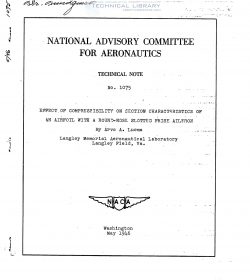naca-tn-1075
- Version
- 173 Downloads
- 1.92 MB File Size
- 1 File Count
- December 2, 2016 Create Date
- December 2, 2016 Last Updated
National Advisory Committee for Aeronautics, Technical Notes - Effect of Compressibility on Section Characteristics of an Airfoil with a Round Nose Slotted Frise Aileron

Compressibility effects on the aerodynamic section
characteristics of an airfoil with a round—nose slotted
Frise aileron were investigated from pressure distributions
obtained at various airfoil angles of attack and aileron_
angles for Each numbers from 0.25 to approximately 0.76.
The aileron tested represented a modification of a sharp-
nose Prise aileron previously investigated by the NACA.
The modification included an-increased nose radius as well
as an increased balance chord.
Modifying the nose of the aileron improved the
section aileron effectiveness Ad/Ada at large negative_
aileron deflections and slightly reduced the effective-
ness at moderate aileron deflections. The wind-tunnel
data indicated a reduction in stick force and an improve—
ment in stick-force characteristics at high diving speeds;
however, the tendency of the up—going aileron tOWard ex-
cessive overbalance at these high speeds still existed.
Section aileron loads were essentially unchanged by
modifying the aileron nose.
Flight tests of a high-speed, fighterttype air-
plane with sharp—nose ailerons showed heavy stick forces
at large aileron deflections and undesirable aileron over-
balance tendencies in high—speed dives. These aileron
difficulties were further evidenced by the results of the
high-Speed tunnel tests (reference 1) of an aileron :.
model based on the midseotion of the original sharp-nose
aileron used on this airplane. In order to improve the
lateral—control characteristics of the airplane, the
Langley Flight Research Division modified the original
aileron by increasing the nose radius and nose overhang.
Flight tests of this modified aileron were made and
reported in reference 2.
The high-speed-tunnel tests of the sharp—nose aileron
model reported in reference 1 were extended to include
tests of an aileron model based on the midsection of the
NACA modified aileron developed for use on a high-speed
fighter~type airplane. Complete pressureristribution’
measurements over the main portion of the airfoil and
modified aileron were made at Mach numbers up to approxi—
mately 0.76 to determine the aerodynamic section charac—
teristics of the airfoil and aileron and the effect—of
compressibility upon these characteristics.
| File | Action |
|---|---|
| naca-tn-1075 Effect of Compressibility on Section Characteristics of an Airfoil with a Round Nose Slotted Frise Aileron.pdf | Download |

Comment On This Post